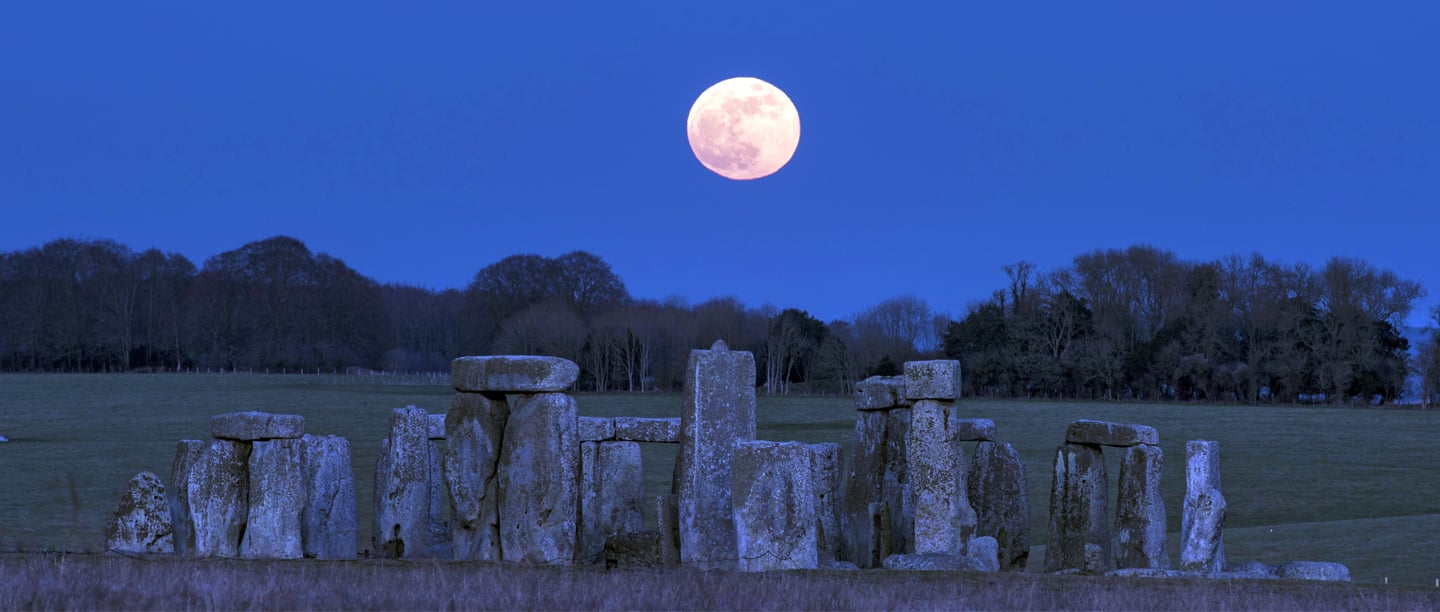What is a Major Lunar Standstill?
Whereas the sun follows a cycle that takes place roughly over the course of a year, the Moon’s cycle is much more rapid. Moonrise and moonset move from their northernmost to southernmost limits and back again in just a month. But the movements of the Moon have a further cycle. The limits of moonrise and moonset change over a period of about 18.6 years.
The major lunar standstill is when the northernmost and southernmost moonrise and moonset are furthest apart.
Stonehenge and the Moon
It’s believed that at least one major standstill was marked during the early phase of Stonehenge, potentially influencing the monument’s design and purpose.
Between 3000 and 2500BC, several centuries before the large stones were brought to Stonehenge, people were burying cremated remains in the ditch and bank that now surrounds the stone circle, and in the Aubrey Holes – 56 pits which may originally have housed upright timber posts or stones. Many of these cremations were clustered in the south-eastern part of the monument, in the direction of the most southerly rising position of the moon, where three timber posts were set into the bank.
There is a further lunar connection at Stonehenge – the long axis of the rectangle formed by the four Station Stones also shares this orientation, in the direction of the southernmost moonrise at the major standstill. Researchers have debated for years whether this was deliberate, and—if so—how this was achieved and what might have been its purpose, so we will have a special chance this year to study if this alignment is truly the case.
The Station Stones may have been employed to help measure out the sarsen circle around 500 years after the site was first used for cremations, when the large sarsen circle was being built, suggesting a compelling and enduring connection between the lunar cycles and the architecture of Stonehenge.
Research
We’re teaming up with experts from Oxford, Leicester and Bournemouth Universities and the Royal Astronomical Society to investigate the alignment of the ancient stones with the moonrise and moonset during this almost once-in a generation event.
The four Station Stones at Stonehenge align with two of the Moon’s extreme positions, and there is much debate as to whether this was deliberate, and if so, what might have been the purpose. A team of archaeoastronomers will explore the complex relationship between the landscape, stones and the Moon over the course of the standstill. Research begins this Spring and observations will continue until mid-2025.
Cultural and spiritual significance
For ancient people the light of the moon would have been useful at night, extending the time available for chores well beyond dusk and even allowing for night-time hunting. In addition, the regularity of the cycle of the lunar phases – from Dark Moon to Full Moon and back again – provided an ideal way to mark the passage of time and organise events and festivities.
Scholars believe that the earliest calendars were based on the phases of the moon and, unlike the Gregorian calendar, there are some lunar or luni-solar calendars still in use today such as the Arabic, Chinese and Hebrew calendars.
On a major lunar standstill, the moon rises and sets in a place on the horizon that the sun never reaches. For people who track the movement of the sun across the year – such as farming communities who use horizon calendars for planting and harvesting – the appearance of the moon further north and south than the extremes of the sun may have been highly significant. Perhaps this would have been a moment when the lunar deity was stronger than the solar one.
Happening only every 19 years or so, the major lunar standstill would have been a generational event – spoken about in the stories that passed orally from one generation to the next. The phenomenon may have marked huge celebrations of religious, spiritual and social significance, and perhaps also mark the time for the rites of initiation of young members of the community into adulthood.
Further Reading
Erica Ellingson and Fabio Silva, ‘The Major Lunar Standstill Season is Here!’, Journal of Skyscape Archaeology, 9 (2), (2024), 281-288
